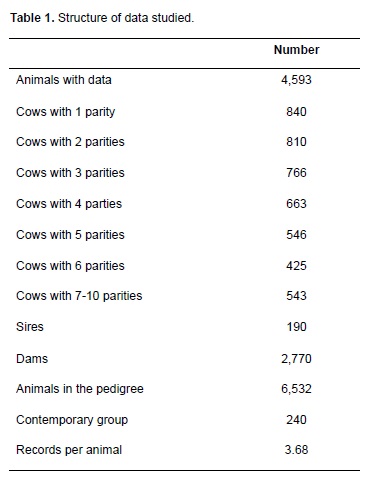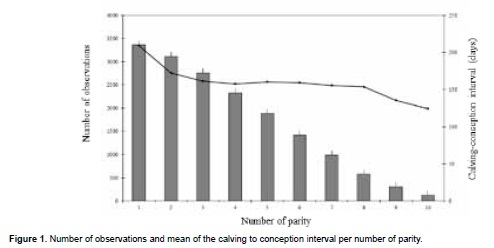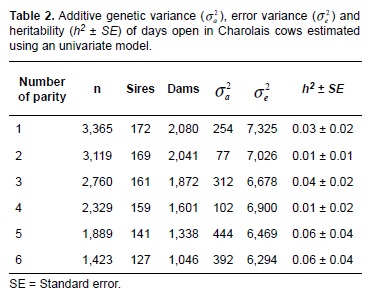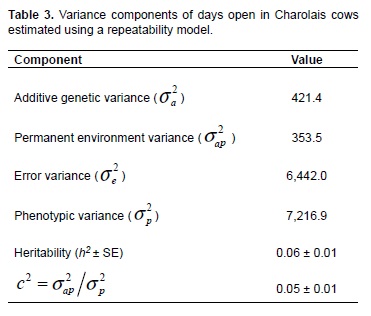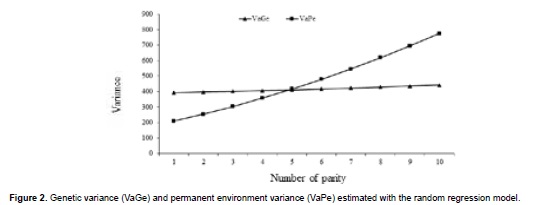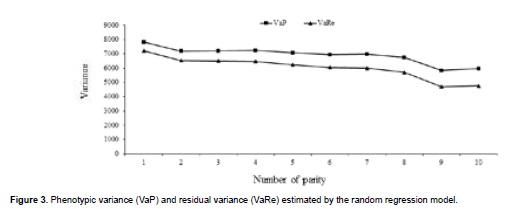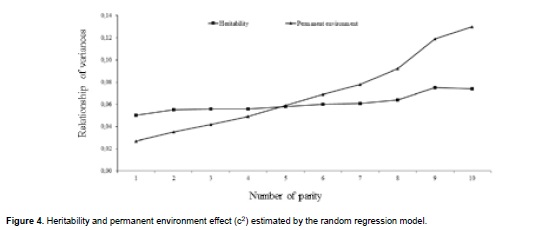Services on Demand
Journal
Article
Indicators
-
 Cited by SciELO
Cited by SciELO -
 Access statistics
Access statistics
Related links
-
 Cited by Google
Cited by Google -
 Similars in
SciELO
Similars in
SciELO -
 Similars in Google
Similars in Google
Share
Revista Colombiana de Ciencias Pecuarias
Print version ISSN 0120-0690
Rev Colom Cienc Pecua vol.29 no.1 Medellín Jan./Mar. 2016
https://doi.org/10.17533/udea.rccp.v29n1a02
ORIGINAL ARTICLE
doi: 10.17533/udea.rccp.v29n1a02
Genetic parameters of days open in Charolais cattle of Cuba¤
Parámetros genéticos de los días abiertos en ganado Charolais de Cuba
Parâmetros genéticos dos dias vazios no gado Charolês de Cuba
José L Espinoza1, MVZ, PhD; Dianelys González Peña2, MV, MSc; Alejandro Palacios Espinoza1*, MVZ, PhD; Ricardo Ortega1, IZ, PhD; Ariel Guillén1, IZ, PhD.
1Universidad Autónoma de Baja California Sur, México. Carr. al Sur, km. 5.5, La Paz, B.C.S. CP 23080. México.
2University of Illinois, USA.
*Corresponding author: Alejandro Palacios Espinoza. Universidad Autónoma de Baja California Sur, Carr. al sur, Km 5.5, CP 23080. La Paz, BCS; México. E-mail: jlvilla@uabcs.mx
Received: December 12, 2014; accepted: September 3, 2015
Summary
Background: there is little information in Cuba regarding the genetic components of the postpartum period in beef cattle. Objective: to compare estimates of genetic parameters of days open (DO) obtained with three models in Charolais cattle of Cuba. Methods: data from individual reproductive control of Charolais cattle from 17 herds in two Cuban companies were analyzed. The sample consisted of 16,891 calvings from 4,593 cows, daughters of 190 sires and 2,770 dams. Up to 10 parities per female between years 1981 and 2005 were considered. The WOMBAT program was used to estimate variance components. Three models were applied; an univariate model (UM) for each separate parity until the sixth calving; a repeatability model (RM) with all parities; and a random regression model (ARM) taking the number of calving as an independent variable. Results: the overall average for DO was 171 ± 93 days. The trend of the average value for DO in each calving was decreasing from the first to the tenth parity, with a seasonal performance around 155 days between the fourth and eighth calving. DO heritability estimated by UM was variable, with values of 0.03 for the first calving and 0.06 for the sixth. These variations cannot be observed with RM that estimated a heritability of 0.06. Values of 0.05 in the first calving until 0.07 in the tenth were estimated with ARM. Genetic correlations among DO for different parities were close to unity. Conclusions: changes of the estimated heritability for DO through the productive life of a female can be observed with ARM. The heritability estimates were low and did not differ from the results reported in other beef cattle breeds.
Keywords: beef cattle, fertility, genetic correlations, heritability, post-partum interval.
Resumen
Antecedentes: en Cuba existe poca información relacionada con los componentes genéticos del periodo posparto en bovinos para carne. Objetivo: comparar los estimados de parámetros genéticos de los días abiertos (DO) obtenidos con tres modelos en ganado Charolais de Cuba. Métodos: los datos del control reproductivo individual de vacas Charolais de 17 hatos en dos empresas de Cuba fueron analizados. La muestra estuvo conformada por 16.891 partos de 4.593 vacas, hijas de 190 padres y 2.770 madres. Fueron considerados hasta 10 partos por hembras que ocurrieron entre 1981 y 2005. Se utilizó el programa WOMBAT para la estimación de componentes de varianza. Se aplicaron tres modelos; un modelo univariado (UM) para cada parto independiente hasta el sexto parto; un modelo de repetibilidad (RM) con todos los partos; y un modelo de regresión aleatoria (ARM) tomando el número del parto como variable independiente. Resultados: la media general de DO fue de 171 ± 93 días. La tendencia del valor promedio para DO en cada parto fue decreciente desde el primero al décimo, con un comportamiento estacional alrededor de 155 días entre el cuarto y el octavo parto. La heredabilidad de DO estimada por UM fue variable con valores de 0,03 en el primer parto y 0,06 en el sexto. Estas variaciones no pueden ser observadas con el RM que estimó una heredabilidad de 0,06. Valores de 0,05 en el primer parto hasta 0,07 en el décimo fueron estimados con el ARM. Las correlaciones genéticas entre DO para los diferentes partos fueron cercanos a la unidad. Conclusiones: los cambios de la heredabilidad estimada para DO a través de la vida productiva de una hembra pueden ser observados con los ARM. Los estimados de heredabilidad fueron bajos y no difiere de los resultados reportados en otras razas de ganado bovino para carne.
Palabras clave: bovinos para carne, correlaciones genéticas, fertilidad, heredabilidad, intervalo post-parto.
Resumo
Antecedentes: em Cuba há pouca informação sobre os componentes genéticos do período pós-parto em bovinos de corte. Objetivo: comparar as estimativas de parâmetros genéticos de dias vazios (DO) obtidos com os três modelos em bovinos Charolês de Cuba. Métodos: os dados de controle reprodutivo individual de bovinos Charolês de 17 rebanhos em duas empresas de Cuba foram analisados. A amostra consistiu de 16.891 partos de 4.593 vacas, filhas de 190 touros e 2.770 matrizes. Até 10 partos foram considerados por fêmea que ocorreram entre 1981 e 2005. O programa WOMBAT foi utilizado para estimar os componentes da variância. Três modelos foram aplicados; um modelo univariado (UM) para cada paridade separado até o sexto parto; um modelo de repetibilidade (RM) com todas as parições; e um modelo de regressão aleatória (ARM), tendo o número de partos como uma variável independente. Resultados: a média geral foi de 171 ± 93 dias. A tendência do valor médio para o DO em cada parto foi diminuindo desde o primeiro até o décimo parto com um desempenho sazonal em torno de 155 dias entre o quarto e oitavo parto. A herdabilidade estimada para DO pela UM foi variável com valores de 0,03 no primeiro parto e 0,06 no sexto. Essas variações não podem ser observadas com RM que estimou uma herdabilidade de 0,06. Os valores de 0,05 no primeiro parto até 0,07 no décimo foram estimados com ARM. As correlações genéticas entre DO para diferentes partos foram próximas da unidade. Conclusões: alterações da herdabilidade estimada para DO durante a vida produtiva de uma fêmea pode ser observado com ARM. As estimativas de herdabilidade foram baixas e não diferiram entre os resultados apresentados em outras raças de gado de corte.
Palavras chave: bovino de corte, correlação genética, fertilidade, herdabilidade, intervalo pós-parto.
Introduction
Genetic improvement in beef cattle has mainly focused on growth characteristics (Goyache et al., 2005). However, reproduction is an important trait (Meirelles et al., 2009). Economic losses in beef cattle due to fertility problems are mainly caused by prolonged calving intervals, low production of calves per year, high culling rates, increased costs of replacements, and reduced productive life of cows.
Traits used for the genetic evaluation of fertility have low heritability indices (Espinoza et al., 2007); this may partially due to the influence of environmental factors on reproductive parameters used in breeding programs (Arellano et al., 2006).
Calving interval is an indicator of reproductive efficiency in bovines. However, this parameter causes a delayed diagnosis of fertility because when an excessive calving interval is identified the decline in productivity is a fait accompli (Arellano et al., 2006). Another measurement to assess reproductive efficiency is the interval between calving and new pregnancy, also known as days open (DO). Obtaining information from DO requires less time than the calving interval; for that reason, the use of DO in selection is justified to improve reproductive behavior (Goyache et al., 2005). Since DO is repeatedly measured through the life of the animal it is important to know the genetic relationship between measurements made after the different parities (De Luna et al., 2008).
It has been suggested that reproductive behavior of the previous calving may affect the current parity and that this behavior in cows may change from one calving to another (Guerra-Iglesias et al., 2009); for this reason, a random regression model is a good tool to study such variability.
Cuba has not conducted a consistent genetic improvement of reproductive traits in beef cattle. At present, there is an information gap, especially on genetic components involved in traits specifically related to the postpartum period. Heritability, as a value to express and measure the average additive effect of genes, is one of the main characteristics of quantitative traits in populations; knowledge of heritability is necessary to estimate breeding values and has a significant impact on breeding programs. In addition, genetic correlations between different quantitative traits are important for indirect selection (Pantelic et al., 2011). For the above reasons, the purpose of this study was to compare estimates of genetic parameters of days open employing different models in Charolais cattle of Cuba.
Material and methods
Study area
Data were obtained from the system boards for individual control of Genetics Cattle Enterprise Camilo Cienfuegos province of Pinar del Rio in western Cuba (21º 54', 23º 00' N and 84º 57', 83º 00' W) and the Genetics Cattle Enterprise Manuel Fajardo in Granma province in the east of the country (19º 50', 20º 39' N and 76º 22', 77º 44' W). The annual rainfall in Pinar del Río and Granma is 1,335 and 1,288 mm, respectively. In most of the Republic of Cuba, the predominant climate is hot tropical; there are two distinct seasons, a dry season (winter) from November to April, and a rainy season (summer) from May to October. The average annual temperature is 25 °C (20 °C in winter and 26 to 27 °C in summer). The average relative humidity is 80% (ONE, 2008).
Management of animals
Cattle are raised under grazing conditions all year round and fed on natural pastures such as Tejana (Paspalum notatum), Camagüeyana (Bothriochloa pertusa), guinea arable pastures (Megathyrsus maximum) and star grass (Cynodon nlemfuensis). Cattle are also fed tree species as carob (Albizia saman), pinion (Glyricidia sepium) and Guaje (Leucaena leucocephala) with some native legumes (Desmodium, Centrosema, and Calopogonium).
The breeding system is based on artificial insemination and natural rearing of calf. Calves remain with their mothers until weaning at 7 months of age.
Data
Individual reproductive records of Charolais cows from 17 herds of two Cuban enterprises were analyzed. The sample consisted of 16,891 lactations from 4,593 cows, daughters of 190 sires and 2,770 dams. Up to 10 parities per female occurring between 1981 and 2005 were considered. It was taken into account during data editing that intervals between calving and positive insemination (DO) were between 40 and 440 days. Table 1 presents additional information on the characteristics of the sample studied.
Used models
Three models were used to estimate (co)variance components of DO. The first was an univariate model (UM) where each observation was analyzed independently for each of the DO in the first six calvings, due to the fact that the sample for subsequent parities was considered small. This model included the contemporary group that considered the combination of herd, year and quarter of calving as fixed effects, and the animal and residual error as random effects. The second was a repeatability model (RM), which included all parities (up to 10). The fixed and random effects in the model were as in the UM, with the addition of the fixed effect of parity number and random effect of permanent environment. The third was a random regression model (ARM) using Legendre polynomials of the first order and the parity number as a covariate in time. The fixed effects were as in the RM. These models are represented in a matrix form, as follows:
UM: y = Xb + Za + e RM: y = Xb + Za + Wap + e
Where:
X, Z, and W = are the incidence matrices for fixed effects, random genetic additives and permanent environment, respectively. It is further assumed:
E(y) = Xb; E(a) = 0; E(ap) = 0; E(e) = 0
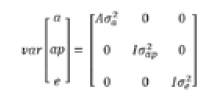
Where:
A = is the matrix of additive genetic relationships between individuals.
I = is the identity matrix.
σa2= is the additive genetic variance.
σap2 = is the variance of the permanent environment effects.
σe2= is the error variance.
Schaeffer (2004) suggests that the reproductive behavior of previous calving may affect actual parity and that this behavior in cows may change from one calving to another and, for that reason, a random regression model is a good choice to study this variability. The statistical model used for ARM is described below.

Where:
yij = is the j-th record of the i-th animal.
GC = represents the fixed effects (herd-yearquarter of calving).
ΚA and ΚR= represent the fit order of the polynomial regression coefficients for components of additive genetic variance and permanent environment, respectively.
αim and γim = represent the random regression coefficients and permanent environment for the i-th animal, respectively.
Φm = is the m-th Legendre polynomial.
tij* = is the j-th number of standardized parity of the i-th animal (from -1 to +1) according to the formula:

Where:
parity no.min = 1 and parity no.max = 10.
It is assumed that E(y) = Xb and V(y) = Z(KG⊗A) Z' + W(KP⊗I)W' + R, a∼N(0,A⊗KG), p∼N(0,I⊗KP) and e∼N(0, Iσe2)
Where:
I = is the identity matrix.
A = is the matrix of additive relationships between individuals.
KG and KP = are the matrices of (co) variance of genetic and permanent environment coefficients, respectively.
R = is the variance of the effects of temporal environment.
The residual variance is assumed heterogeneous (ten classes according to number of parity).
The WOMBAT program (Meyer, 2006) was used to estimate the components of (co) variance and genetic parameters.
Results
General average of DO was 171 ± 93 days with 54.8% coefficient of variation. Figure 1 shows that the number of observations ranged from 3,365 in the first parity, up to 128 in the tenth. The DO average at first parity was 209 days, decreased to the third (161 days) parity, then remained almost unchanged until the eighth parity and decreased in the ninth (135 days) and tenth (124 days) parities.
Variance components and heritability values estimated by UM are presented in Table 2.
An increase in the additive variance from first, third and fifth parity, with a small decrease in the sixth parity, was observed. The additive variance was lower in the second and fourth parity. The residual variance had a decreasing trend from first to sixth parity. Heritability of DO tended to increase, albeit inconsistently, as the number of parities increases.
Table 3 presents the variance components and heritability estimated by RM. It is noted that the additive and residual variances take intermediate values compared to those obtained with UM, and the variance of permanent environment reaches a value below the additive variance. Heritability estimated with RM was similar to most of the values obtained with UM. Table 3 shows that the effect of permanent environment reached 5% of the total variability.
Figure 2 shows the additive genetic and permanent environment variances when ARM was applied. The trend of the additive variance through calving was almost constant throughout the trajectory with a slight increase in the last three parities.
The permanent environment variance tended to increase from first to tenth parity. Figure 3 shows a decreasing trend in the residual and phenotypic variances.
Heritability values estimated by ARM (Figure 4) tended to increase from first to tenth parity, with values somewhat higher than those estimated with UM.
The genetic correlations estimated by ARM between DO in different parities had values between 0.98 and 0.99.
Discussion
The DO mean was similar to that reported by Guerra-Iglesias et al. (2009) in Santa Gertrudis cattle of Cuba (169 days), lower than that reported in Simmental (Spasic et al., 2012) and higher than that reported by other authors for different beef cattle breeds (Santana et al., 2004; Goyache et al., 2005).
A trend of DO in different parities similar to this of the present work was found in the Asturiana de los Valles breed (Goyache et al., 2005). This coincides with other studies in which DO were found less prolonged in Romosimuano females between 5 and 9 years of age (Ossa et al., 2006). These results may be associated with the fact that growth and lactation occur in parallel in first parities, since usually the adult size of females has not been reached and nutrients consumed during this period can be used for maintenance, growth and lactation, which affects fertility and causes the extension of postpartum anestrus. In addition, DO derived from this study may differ from those reported by other authors considering that the aforementioned trait depends largely on livestock feed, as well as health and reproductive management, which often vary among herds (Zambrano and Echeverri, 2014).
The genetic parameters estimated for DO using UM and RM were similar due to the small variation of the variance components for the additive genetic effect. This indicates that it is about traits predominantly influenced by environmental effects and by the contribution of dominant or epistatic genes where the additive genetic variance contributes little to the total variance (Gressler et al., 2005; Bertipaglia et al., 2007).
There is much literature on the estimation of variance components in reproductive traits in dairy cattle (Oseni et al., 2004; Chang et al., 2006; Restrepo et al., 2008; Estrada-León et al., 2008; Ghiasi et al., 2011; Zambrano and Echeverri, 2014) and most agree that heritability varies between 0.03 and 0.08. Literature on beef cattle is scarce. In Simmental cattle, heritability estimates of 0.10 are reported using a mixed model (Pantelic et al., 2011) and 0.12 using the mother-daughter regression method (Spasic et al., 2012). Using multivariate models, heritability values higher than those of this study in the first (0.16) and second (0.19) parity have been found, as well as between the third and ninth (0.17) parity and a heritability of 0.09 for the DO in subsequent parities (Goyache et al., 2005). Estimates of lower values (0.05) were published for the Japanese Black cattle (Oyama et al., 2004).
An important component of DO is the length of postpartum anestrus, which has registered a moderate heritability (0.38) in Charolais cattle when the estimate was based on the days between calving and the first increase in blood progesterone; however, heritability index was reduced to 0.11 when it was estimated based on the first estrus observed (Mialon et al., 2001).
The heritability value estimated with RM is similar to that reported in Cuba by Santana et al. (2004) in Zebu (0.06 ± 0.006) breed, by Véliz et al. (2004) in Santa Gertrudis (0.07 ± 0.01) and by Guerra-Iglesias et al. (2009) in Santa Gertrudis (0.056 ± 0.01) using the same model.
The variance of permanent environment estimated with RM in this study resulted lower than the genetic variance. The permanent environment effect (c2 = 5%) was lower than that reported for Asturiano de los Valles cattle (Goyache et al., 2005) in which c2 values of 9.6% were observed using the DO of the entire sample and of 9.1% when using the DO of only the first and second parity.
The heritability estimated with ARM slightly increased between first, ninth and tenth parity, with similar values to those obtained with UM. However, using ARM, the erratic trend observed with UM was not seen, given that ARM is based on a covariance function which tends to model in a smoother and uniform way the variance estimates. In dairy cattle, by means of ARM a genetic variance increase of DO was found as the number of parity increased (Jansen et al., 1987). Goyache et al. (2005) found a higher genetic variability in younger animals in the Asturiana de los Valles breed and it was attributed to the fact that older animals have a more stable reproductive behavior than the bias produced by selection in older cows. However, the population studied had never been selected for reproductive behavior.
The genetic correlations close to unity suggest that DO measured in different parities are controlled by the same genes. Using a random regression model, genetic correlations close to unity among the first three parities have been estimated, but not so with subsequent parities (Guerra-Iglesias et al., 2009; Gonzalez-Peña et al., 2010).
Philipsson (1981) found genetic correlations between 0.81 and 0.90 between young and adult animals in dairy cattle and suggested the possibility that the same genes affect this trait measured at different ages.
Based on the results of the present study, it can be concluded that days open in Charolais cattle in Cuba are weakly influenced by the additive effect of genes, as a consequence of low heritability, and do not differ from results found in other beef cattle breeds. Fluctuations that estimated heritability undergoes for DO through the productive life of a female can be observed with ARM models.
Acknowledgements
We would like to thank Dr. Danilo Guerra Iglesias (†) for his valuable participation in this research.
Conflicts of interest
The authors declare they have no conflicts of interest with regard to the work presented in this report.
Notes
¤To cite this article: Espinoza JL, González D, Palacios A, Ortega R, Guillén A. Genetic parameters of days open in Charolais cattle of Cuba. Rev Colomb Cienc Pecu 2016; 29:16-24.
References
Arellano S, Martínez J, Romero E, Briones F, Domínguez M, de la Garza F. Factores genético-ambientales que afectan el intervalo entre partos y días al primer parto del ganado de doble propósito en el norte de Veracruz. AIA 2006; 10:43-53. [ Links ]
Bertipaglia EC, Gomes da Silva R, Cardoso V, Campos AS. Estimativas de parâmetros genesticos e fenotispicos de caracterissticas do pelame e de desempenho reprodutivo de vacas holandesas em clima tropical. R Bras Zootec 2007; 36:350-9. [ Links ]
Chang YM, Andersen Ramberg IM, Heringstad B, Gianola D, Klementsdal G. Bivariate analysis of number of services to conception and days open in Norwegian Red using a censored threshold-linear model. J Dairy Sci 2006; 89:772-8. [ Links ]
De Luna R, Guerra D, González Peña D, Espinoza JL, Palacios A, Núñez R. Componentes de (co)varianza de caracteres reproductivos y su relación genética con el peso al destete en ganado Cebú de Cuba. Tec Pecu Mex 2008; 46:225-34. [ Links ]
Espinoza JL, Palacios A, de Luna R, Ávila N, Guerra D, González- Peña D, Rodríguez F, Mellado M. Componentes de (co)varianza para caracteres de crecimiento y reproducción en Ganado cebú en Cuba. Arch Zootec 2007; 56:919-27. [ Links ]
Estrada León RJ, Magaña JG, Segura Correa JC. Genetic parameters for reproductive traits of Brown Swiss cows in the tropics of Mexico. J Anim Vet Adv 2008; 7:124-9. [ Links ]
Ghiasi H, Pakdel A, Nejati Javaremi A, Meharabani Yeganeh H, Honarvar M, González Recio O, Carabaño MJ, Alenda R. Genetic variance components for female fertility in Iranian Holstein cows. Livest Sci 2011; 139:277-80. [ Links ]
González Peña D, Espinoza Villavicencio JL, Guerra D, Palacios A, Evora JC, Portales A. Components of (co)variante of the days open in Siboney dairy cows. Arq Bras Med Vet Zootec 2010; 62:136-43. [ Links ]
Goyache F, Gutiérrez JP, Fernández I, Royo LJ, Álvarez I. Genetic analysis of days opens in beef cattle. Livest Prod Sci 2005; 93:283-9. [ Links ]
Gressler MGM, Pereira JCC, Bergmann JAG, Andrade VJ, Paulino MF, Gressler SL. Aspectos genéticos do peso à desmama e de algumas características reprodutivas de fêmeas Nelore. Arq Bras Med Vet Zootec 2005; 57:533-8. [ Links ]
Guerra Iglesias D, Espinoza Villavicencio JL, Palacios Espinosa A, González Peña D, Rodríguez Almeida F, Guillen Trujillo A. Componentes de (co)varianza de los días abiertos en bovinosSanta Gertrudis. Tec Pecu Mex 2009; 47:145-55. [ Links ]
Jansen J, Van der Werf J, de Woer W. Genetic relationships between fertility traits for dairy cows in different parities. Livest Prod Sci 1987; 17:337-49. [ Links ]
Meirelles S, Espasandin AC, Mattar M, de Queiroz S. Genetic and environmental effects on sexual precocity traits in Nellore cattle. R Bras Zootec 2009; 38:1488-93. [ Links ]
Meyer K. WOMBAT- Digging deep for quantitative genetics analyses by restricted maximum likelihood. Proceedings of the 8th World Congress of Genetic Applied to Livestock Production; 2006 Aug 13-18; Belo Horizonte, Minas Gerais, Brasil. [ Links ]
Mialon MM, Renend G, Krauss D, Ménissier F. Genetic relationship between cyclic ovarian activity in heifers and cows and beef traits in males. Genet Sel Evol 2001; 33:273-87. [ Links ]
ONE. Oficina Nacional de Estadísticas. República de Cuba 2008; [Access date: December 1, 2014]. URL:http://www.one. cu/publicaciones/50aniversario/medio%20ambiente/public%20 completa.pdf. [ Links ]
Oseni S, Tsuruta S, Misztal I, Rekaya R. Genetic parameters for days open and pregnancy rates in US Holsteins using different editing criteria. J Dairy Sci 2004; 87:4327-33. [ Links ]
Ossa G, Suárez M, Pérez J. Factores ambientales y genéticos relacionados con el intervalo entre partos en la raza Romosinuano. Rev MVZ Córdoba 2006; 11:799-805. [ Links ]
Oyama K, Katsuta T, Anada K, Mukai F. Genetic parameters for reproductive performance of breeding cows and carcass traits of fattening animals in Japanese Black (Wagyu) cattle. Anim Sci 2004; 78:195-201. [ Links ]
Pantelic V, Sretenovic L, Ostojic-Andric D, Trivunovic S, Petrovic MM, Aleksic S, Dragana R. Heritability and genetic correlation of production and reproduction traits of Simmental cows. Afr J Biotech 2011; 10:7117-21. [ Links ]
Philipsson, J. Genetic aspects of female fertility in dairy cattle. Livest Prod Sci 1981; 8:307-19. [ Links ]
Restrepo G, Pizarro E, Quijano JH. Índices de selección y niveles independientes de descarte para dos características productivas y reproductivas en un hato Holstein (Bos taurus). Rev Colomb Cienc Pecu 2008; 21:239-50. [ Links ]
Santana Y, Guerra D, Veliz D, Falcón R, Rodríguez M, González- Peña D, Ortíz J. Parámetros genéticos y no genéticos que afectan las características reproductivas de la hembra Cebú en Cuba. Rev Cubana Reprod Anim 2004; 30:39-46. [ Links ]
Schaeffer LR. Application of random regression models in animal breeding. Livest Prod Sci 2004; 86:35-45. [ Links ]
Spasic Z, Stolic N, Milosevic B, Ilic Z, Andusic L. Age influence at the first insemination and the service period on longevity and life-long production of milk in Simmental cows. Macedonian J Anim Sci 2012; 2:253-6. [ Links ]
Véliz D, Guerra D, Falcón R, Santana Y, Rodríguez M, González- Peña D. Parámetros genéticos y no genéticos que afectan la reproducción en la raza Santa Gertrudis. Rev Cubana Reprod Anim 2004; 30:53-8. [ Links ]
Zambrano JC, Echeverri J. Genetic and environmental variance and covariance parameters for some reproductive traits of Holstein and Jersey cattle in Antioquia (Colombia). R Bras Zootec 2014; 43:132-9. [ Links ]













